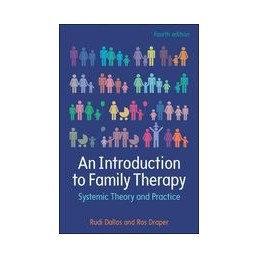- Reduced price

Order to parcel locker

easy pay


 Delivery policy
Delivery policy
Choose Paczkomat Inpost, Orlen Paczka, DHL, DPD or Poczta Polska. Click for more details
 Security policy
Security policy
Pay with a quick bank transfer, payment card or cash on delivery. Click for more details
 Return policy
Return policy
If you are a consumer, you can return the goods within 14 days. Click for more details
The book considers both British and International perspectives and includes the latest developments in current practice, regulation and innovation, looking at these developments within a wider political, cultural and geographical context. The fully revised fourth edition also contains new material on::
EXPANDED Chapter 4 Ideas that keep knocking on the door-updated with applications of attachment & narrative therapy, linking these ideas to issues of developing the therapeutic alliance with familiesExpanded lists of key texts and diagrams, suggested reading organized by topic, and new practical examples and exercises are also used in order to encourage the reader to explore and experiment with the ideas in their own practice.
This book is key reading for students and practitioners of family therapy and systemic practice as well as those from the fields of counselling, psychology, social work and the helping professions who deal with family issues,
The fourth edition of Dallos and Drapers book admirably achieves its aim of giving an overview of the field of systemic therapy from the 1950s to the present day, with a consideration of both British and international perspectives, taking account of the wider political, cultural and geographical context. Like its previous editions, the fourth edition of Dallos and Drapers introductory family therapy book will continue to be a valued resource for both students on family therapy training programmes and experienced professionals. I recommend it highly.
Alan Carr, Review in the Journal of Family Therapy, December 2015
Data sheet
Introduction
Experiences of systemic and family therapy
A familys view
Two therapists views
What is the family?
The family life cycle
Allowing the family a voice
The organizing framework of this book
Key texts offering a historical overview of systemic and family therapy
Setting the scene – 1950s
1. The first phase – 1950s to mid-1970s
Cultural landscape
Influential people and ideas
Practice
Commentary
Key texts
Skill guides
2. The second phase – mid-1970s to mid-1980s
Cultural landscape
Influential people and ideas
Practice
Commentary
Key texts
Skill guides
3. The third phase – mid-1980s to 2000
Cultural landscape
Influential people and ideas
Practice
Commentary
Key texts
Skill guides
4. Emotions and attachments as the driving force in family systems
Emotions and early family therapy concepts
Attachment theory
Attachment-oriented systemic therapies
Reflections and summary
Key texts
5. Systemic formulation and formulating
Systemic theory: Formulation and formulating
A case example of systemic formulation
Formulating
Commentary
Key texts
Skill guides
Systemic formulation
6. Twenty-first century practice development: Conversations across the boundaries of models
Cultural landscape
Practice
Commentary
Key texts
7. Couple therapy
Culture, family and couples contexts
Approaches to couple therapy
Influential people, ideas and services
Twenty-first century practice and service developments
Commentary
Key texts
8. Research and evaluation
Introduction
Why conduct research?
Evidence-based practice and practice-based evidence
Science, research and systemic therapy
Evaluation research: Does family therapy work?
Therapy process research
Family theory research
Discussion and reflections
Key texts
9. Reflections 2015
Current state of the art
Crystal-ball gazing
Developmental perspectives
Review and summary
Integrations
